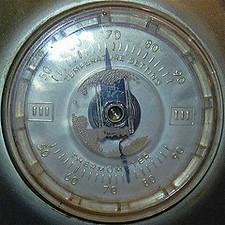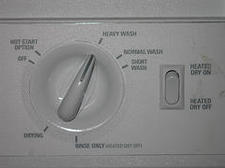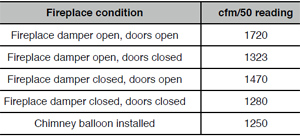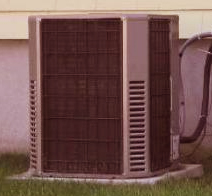
by blogediter | May 30, 2018 | Save Energy
Thermostat dial
Q: Jason – My home is mostly closed right now due to the heat of the summer and the cost of electricity to run the air conditioning. I am doing the simple steps to save money on my air conditioning, but what about air quality? I am essentially recycling air in my home just like in the winter. – TY
A: TY – You are absolutely correct. It doesn’t matter if it is winter or summer if you have your windows closed and the air or heater on…you are recycling air and it could be low quality air.
The US EPA says the most energy efficient and cost and the energy friendly way to deal with stale air is “Source Control” of indoor pollutants. This essentially means you need to stop doing things that contaminate your indoor air.
Here are 4 steps to help you with this issue.
Step 1: Plug the bad air intake spots. Your house is going to tend to suck in air because of the negative pressure created by fans, AC, furnaces, wood or corn burners, or other sources. In the winter time, this is more noticeable because this inward pressure manifests itself as cold drafts that are easy to identify. In the summer warm drafts are tougher to spot. Plug up the worst bad air intake spot in your home: the fireplace chimney. The chimney acts as a filthy snorkel as it is often the path of least resistance for air to enter your home. Imagine breathing in through a creosote and ash filled snorkel and you will see why it is important to plug this air entry point airtight. Closing the damper is a good start but a Chimney Balloon will help you get the tight seal that you really need to keep your home from taking in air through this path.
Step 2: If you are doing an indoor home improvement project that includes painting, sanding, torches, welding, soldering, burning, heat gunning, harsh cleansers like Bleach or Ammonia, or any other activity that puts something into the air other than your breath…you will be better served to open your home to the outside than to keep it closed up. At a minimum, open up the room you are working in to air it out. If you don’t, your return vents suck this in and circulate it through your house repeatedly.
Step 3: Display your nice paraffin or scented candles but don’t burn them. Anything you burn from candles to wood in the fireplace is going to introduce toxins into your air through smoke and carbon. There are some friendlier Soy-based candles that are not nearly as polluting as regular scented candles, but they should be used with a trimmed wick so the flame does not get too long. This probably goes without saying but smoking cigarettes and pipe in the house is horrible for everyone in the home, especially when the house is closed.
Step 4: Don’t bother with tabletop air purifiers or ridiculous amounts of houseplants. The US EPA does not certify or endorse air cleaning filters. And third-party testing labs like Consumer Reports do not give glowing reviews of any air filter products. As a matter of fact, they have found some filter systems tend to introduce more ozone than is healthy. And the US EPA says the small amount of plants helps with carbon dioxide levels but does nothing for air pollutants. Too many moist plants can cause mold issues. When it comes to air filters and plants it is best to focus your energy on other ways to make a dent in indoor pollutants.
by blogediter | May 16, 2018 | Save Energy
Q: The Chimney Balloon website says that it can save a homeowner up to 30% on the home heat. How do you get this figure?
A: The 30% savings is if you have no damper on your fireplace or if the damper is stuck open. The Department of Energy estimates a home with no damper on the fireplace will increase its heating bill 30%. The DOE website mentions the Chimney Balloon in an indirect way on the website as an “inflatable stopper” See this link here: http://www.eere.energy.gov/consumer/your_home/space_heating_cooling/index.cfm/mytopic=12570
Below is the quote from the DOE website:
“Flues are ideal for leaking heat and warm air out of your home. If you have a fireplace that you don’t use, plug and seal the flue. If you use the fireplace, be sure to close the flue when the fireplace is not in use. You could also use an inflatable stopper, available commercially, to temporarily seal the chimney and avoid air leakage through the flue.”
The above quote is Copyright property of the US Department of Energy.
Your heat savings will be less than 30% if you do have a functioning damper, but even the best of metal dampers are often only 75% efficient since they have no insulation and they conduct cold. Most used metal dampers are less than 50% efficient due to warping and corrosion.

by blogediter | May 11, 2018 | Save Energy
Dish Washer dial
Follow these two simple rules and use your energy efficient dishwasher guilt-free:
1) Only wash full loads of dishes
2) Dont pre-rinse your dishes before putting them in the dishwasher
If you really want to be energy efficient about it don’t use the dry cycle, but instead, leave your dishwasher open overnight to let them air dry.
According to the University of Bonn Germany research project (pdf), a dishwasher uses half the energy, one-sixth the water and much less soap than hand washing. Newer Energy efficient dishwashers with the Energy Star Label can save a homeowner up to $25 per year over older models. Energy efficient units clean better use up to 30% less water and use less soap.
Read more on this topic by reading Larry Wests article at About.com. Larry West is an environmental expert, that is an environmental topic guide on About.com
by blogediter | May 9, 2018 | Save Energy
Here is an excerpt from a blog on phantom power usage at www.treehugger.com. Phantom power usage is an increasing waste of power from unused household stuff that drains power
Below is an excerpt from what the article is about:
“Call it what you will: phantom load, idle current, vampire power, wall wart; they’re all euphemisms for the way devices use and waste electricity when they aren’t even on, and they’re everywhere. Here are some ways to save some bucks and carbon emissions and gain some peace of mind by eliminating unnecessary power use in your home.”
read the entire entry here: http://www.treehugger.com/files/2006/12/cut_back_on_pha.php

by blogediter | Apr 4, 2018 | Save Energy
Fireplace damper testing graph
Chimney Balloon USA had a certified energy rater test to see what sealed a home tighter… a metal damper, fireplace glass doors, or a Chimney Balloon.
Who: A third party Focus on Energy certified energy rater (Mark Furst with Grading Spaces Inc) did a blower door testing sequence on a ranch home of 1200 square ft. Mark is certified with Focus on Energy and also with Resnet.
What: The test home was a 1200 square foot ranch style home with a basement. It had one zero clearance fireplace with a 9″ flue and a flapper style metal damper. The fireplace also had a set of tempered glass bifold doors. The home had R-50 cellulose insulation in the attic, R19 fiberglass insulation in the walls. Eight R2 windows and three steel and solid wood exterior doors.
When: The test was performed in Wisconsin in August of 2008.
Why: To see if the Chimney Balloon was better at stopping cold air infiltration than fireplace glass doors or metal Chimney dampers. The test was run on a very small zero clearance fireplace with the minimum size chimney vent of 9″ tube. This chimney and damper is the smallest flue and damper possible for a conventional fireplace. Therefore the savings represent the lowest levels of energy savings you can expect.
According to the results, the Chimney Balloon helped the home save 27% more heat than if the damper was open and the glass doors were open.
The Chimney Balloon saved 15% more heat than the metal damper alone.
The Chimney Balloon saved 6% more heat than the glass doors alone and even worked better than the damper and glass doors combined.
Here is a link to the complete report from the energy rater after he conducted the testing.
http://www.chimneyballoon.us/f/GradingSpaceschimneyballoonreport.pdf

by blogediter | Mar 21, 2018 | Save Energy
Save on A/C when it is hot outside
Q: Dear Jason,
Is there any purpose to using the Chimney Balloon in the summer to seal off chimneys in a house in Arizona that will be closed for the summer? And what if the property is occupied? Does it help with A/C savings? Keep in mind it gets very hot here, will that hurt the Chimney Balloon?
I understand its purpose in the north. I have a home in Illinois for which I am getting one. – KG
A: Dear KG,
We actually get this question a lot. I understand it does get very hot in Arizona (over 110 degrees F). The Chimney Balloon is essentially an air sealing and insulation device that plugs a major home envelope penetration (the chimney). Because of this, it saves A/C in the summer as well. Cool air doesn’t rise like hot air does so the difference is not as noticeable in the hot weather as in cold weather.
But, when you plug a hole in your house tightly it makes a difference on energy bills just by tightening the energy envelope of the home no matter if you are heating or cooling. Besides the insulation factor, homeowners often install a Chimney Balloon in the summer to stop chimney odors and insect and bird/bat entry through the flue.
Also, the Chimney Balloon can handle any temperature up to 180 degrees F. So as long as you don’t have a forecast of 185 degrees *whew* you should be fine. – Jason



